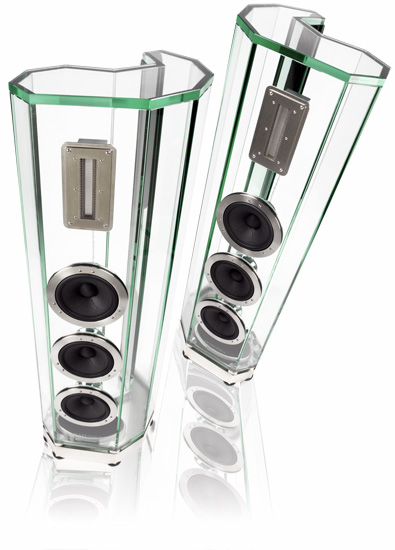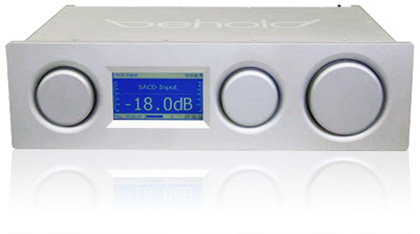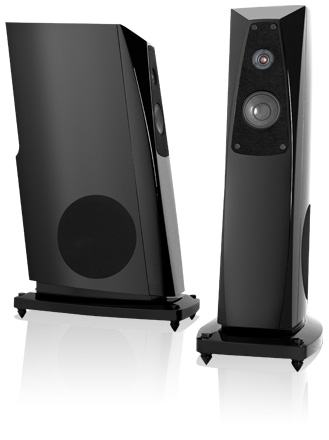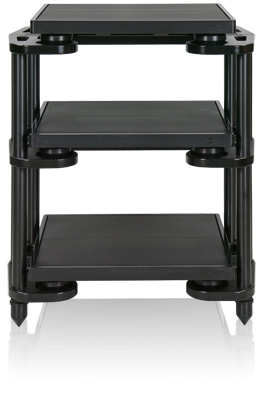| January 1, 2010
More on the new SoundStage! Network, Plus: Our
Products of the Year!
 Last month, in "Addressing a Complaint," I told you all about
the new SoundStageNetwork.com,
and specifically about how it would make navigating the SoundStage! Network websites
easier -- you now need to bookmark only one site, which will then point you toward all
of the Network’s monthly equipment reviews, music and industry features, news, and so
on. I also hinted at a feature that would debut on that new site, our 2009 SoundStage!
Network Equipment Buying Guide. I invite you to peruse the listings in the Guide
and, if something strikes your interest, to click through to read the full review on a
SoundStage! Network website. Starting in January 2010, you’ll be able to access the 2010
SoundStage! Network Equipment Buying Guide as it’s being populated. We hope
the Guide will become an integral part of your research when it’s time for
your next system upgrade. Last month, in "Addressing a Complaint," I told you all about
the new SoundStageNetwork.com,
and specifically about how it would make navigating the SoundStage! Network websites
easier -- you now need to bookmark only one site, which will then point you toward all
of the Network’s monthly equipment reviews, music and industry features, news, and so
on. I also hinted at a feature that would debut on that new site, our 2009 SoundStage!
Network Equipment Buying Guide. I invite you to peruse the listings in the Guide
and, if something strikes your interest, to click through to read the full review on a
SoundStage! Network website. Starting in January 2010, you’ll be able to access the 2010
SoundStage! Network Equipment Buying Guide as it’s being populated. We hope
the Guide will become an integral part of your research when it’s time for
your next system upgrade.
And if the upgrade itch has really hit you . . .
Our Products of the Year are a special group that
represents everything that puts the Ultra in Ultra Audio: extreme
engineering, extreme build quality, and, ultimately, extreme performance. All were
designed by companies that know their crafts in encyclopedic detail, yet manage to
compress myriad design subtleties into single well-rounded products that are, in every
respect, world-class.
The Crystal
Cable Arabesque loudspeaker ($65,000 USD/pair) is from the hearts and minds of Gabi
and Edwin van der Kley, the dynamic duo from the Netherlands that brought you both the
ultra-thin cables that define the Crystal Cable brand, and staples in audiophile circles,
the products from Siltech. Speakers, however, particularly these speakers,
represent a new endeavor for Crystal Cable. Conceived as both visual and sonic
design statements, the Arabesque is special because it succeeds simultaneously in both
realms. These speakers are wildly expensive, but reviewer Jason Thorpe put the price in
context: ". . . I can imagine a music lover who values great sound, who has
more money than God, watching his wife go gaga over the Arabesques as she visualizes these
two massive Swarovski crystals perched in the middle of her living room making wonderful
music. That audiophile, I imagine, would see the Arabesque as an absolute
bargain."
But perhaps Doug Schneider summed up the Arabesque best:
"It's new, unique and, in many ways, very exciting, because it's clearly so
different from almost every speaker on the market. If it finds an audience and takes off,
the Arabesque could be the start of something really new in high-end audio." The
Arabesque just feels like a new kind of high-end-audio product, and maybe
that’s really the overriding point. Perhaps finding a home not just within the
limited scope of high-end audio, but also the more encompassing world of everything
high end, is what makes this product such a resounding achievement.
 The Behold APU768
modular preamplifier-processor-DAC ($58,000 as configured for the review) is unique.
Combining, in a single chassis, a state-of-the-art preamplifier (stereo or multichannel),
a high-quality digital-to-analog converter, and a room-correction processor, the APU768
can serve as the heart of the highest of high-performing audio systems. Unlike those
components in which the functions of separates are combined in an effort to provide
convenience and/or cost savings, the three components that comprise the APU768 eclipse any
three equivalent separates that I know of. Engineer Ralf Ballmann is a perfectionist who
began designing the APU768 with a blank sheet of paper. Although in terms of functionality
the APU768 is more akin to a home-theater processor, it’s intended as a music-only
device. Its purposes are to cure the ills caused by how your room affects the sound of
your system and, through the use of the most advanced system architecture I’ve ever
seen, to overcome the challenges of combining multiple DSP-equipped components. The Behold APU768
modular preamplifier-processor-DAC ($58,000 as configured for the review) is unique.
Combining, in a single chassis, a state-of-the-art preamplifier (stereo or multichannel),
a high-quality digital-to-analog converter, and a room-correction processor, the APU768
can serve as the heart of the highest of high-performing audio systems. Unlike those
components in which the functions of separates are combined in an effort to provide
convenience and/or cost savings, the three components that comprise the APU768 eclipse any
three equivalent separates that I know of. Engineer Ralf Ballmann is a perfectionist who
began designing the APU768 with a blank sheet of paper. Although in terms of functionality
the APU768 is more akin to a home-theater processor, it’s intended as a music-only
device. Its purposes are to cure the ills caused by how your room affects the sound of
your system and, through the use of the most advanced system architecture I’ve ever
seen, to overcome the challenges of combining multiple DSP-equipped components.
Ultimately, however, the APU768 is about fidelity to the
original recording. If I were assembling a state-of-the-art audio system and wanted to
guarantee the best chance of perfecting its high resolution, while keeping open the
possibilities of future expansion and upgrading through the convenience of a modular
design, I can’t think of any other component I’d rather use. You’ve got to
use an APU768 to really appreciate it. Find one to audition.
 The Rockport
Technologies Ankaa loudspeaker ($27,500/pair) is a member of one of the most fiercely
contested price classes in high-end audio. It stands out for several reasons, all of them
related to how it will sound in your listening room: one reason is the completeness of its
design -- a combination of the ultra-high-level engineering and artistic vision that are
part and parcel of the high end. First, there’s no stabbing in the dark for Andrew
Payor, head honcho of Rockport Technologies. His engineering solutions to loudspeaker
problems, pursued to the point of obsession, have been well documented in the electronic
pages of Ultra Audio. But the second element of any high-end design is the artistic
one, and that comes from listening to and knowing music. Payor believes that the sound and
the math should fully support the music; his designs embody this ideal, and the Ankaa is a
prime example. This 200-pound -- and yet jewel-like -- loudspeaker is well below the top
of the Rockport line, but within its capabilities it’s beyond reproach. In his
review, Randall Smith stated that "It’s easily the best speaker I’ve had in
my home, and one of the best I’ve heard anywhere -- and it’s the best
I’ve heard for anywhere near its price." The Rockport
Technologies Ankaa loudspeaker ($27,500/pair) is a member of one of the most fiercely
contested price classes in high-end audio. It stands out for several reasons, all of them
related to how it will sound in your listening room: one reason is the completeness of its
design -- a combination of the ultra-high-level engineering and artistic vision that are
part and parcel of the high end. First, there’s no stabbing in the dark for Andrew
Payor, head honcho of Rockport Technologies. His engineering solutions to loudspeaker
problems, pursued to the point of obsession, have been well documented in the electronic
pages of Ultra Audio. But the second element of any high-end design is the artistic
one, and that comes from listening to and knowing music. Payor believes that the sound and
the math should fully support the music; his designs embody this ideal, and the Ankaa is a
prime example. This 200-pound -- and yet jewel-like -- loudspeaker is well below the top
of the Rockport line, but within its capabilities it’s beyond reproach. In his
review, Randall Smith stated that "It’s easily the best speaker I’ve had in
my home, and one of the best I’ve heard anywhere -- and it’s the best
I’ve heard for anywhere near its price."
To hear and see the Ankaa is to appreciate its quality.
Rarely do you experience a product that so completely embodies what high-end audio is all
about. The Rockport Technologies Ankaa has all the qualities you’d expect in a
speaker at this price -- transparency, neutrality, body -- and some that might surprise
you, such as its extended low-bass response. The Ankaa is comfort food for the tired,
hungry audiophile.
The Harmonic Resolution Systems SXR audio stand ($5995 for the five-shelf
version), S1 Isolation Base ($1695 each), Damping Plate ($195 each), and Nimbus System
(Coupler, $32.50 each; Spacer, $43 each) are not to be considered mere accessories. They
could be, in fact, pivotal in your search for truly great sound from your audio
system.
 Reviewer Garrett Hongo aptly stated,
"If you feel your system has come together in a kind of audio maturity -- a maturity
in which each component seems the best and most sophisticated you could have while still
maintaining synergy with the others -- then you might consider trying an HRS SXR rack
system. For those interested in getting the most out of their audio components, the high
price of the SXR -- the system reviewed costs $15,292 -- shouldn’t be much of an
impediment, as the point would be to get as close to a system’s optimal performance
as possible. I think the SXR will do that." Mike Latvis, Chief Engineer of Harmonic
Resolution Systems, has simply created a system that will banish resonance and, as a
result, open up your system’s performance envelope in ways that would be unobtainable
any other way. Reviewer Garrett Hongo aptly stated,
"If you feel your system has come together in a kind of audio maturity -- a maturity
in which each component seems the best and most sophisticated you could have while still
maintaining synergy with the others -- then you might consider trying an HRS SXR rack
system. For those interested in getting the most out of their audio components, the high
price of the SXR -- the system reviewed costs $15,292 -- shouldn’t be much of an
impediment, as the point would be to get as close to a system’s optimal performance
as possible. I think the SXR will do that." Mike Latvis, Chief Engineer of Harmonic
Resolution Systems, has simply created a system that will banish resonance and, as a
result, open up your system’s performance envelope in ways that would be unobtainable
any other way.
CES bound
As you read this on the first day of the new year,
I’ll be preparing to leave for Las Vegas, Nevada, and the annual Consumer Electronics
Show. CES is a big thing for us at the SoundStage! Network, and I invite you to enjoy our
coverage of the event; the first installment will be posted January 7. Here is where I
usually provide a link to the page where the event coverage will appear. But I know we
have an astute readership that pays close attention, particularly to my
"Opinion" last month, so I’m confident you know just where to look . . .
OK, dang it, I can’t help myself. Go here for CES
coverage: www.soundstagenetwork.com/lasvegas2010/
. . . Jeff Fritz
jeff@ultraaudio.com
|